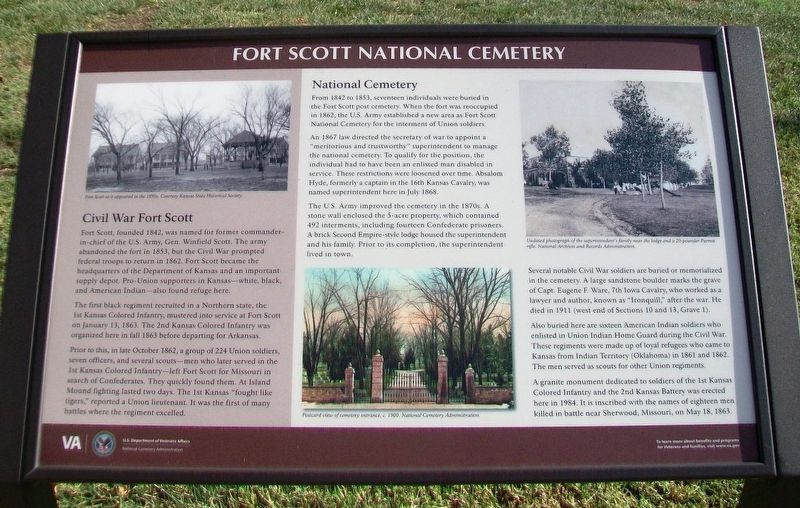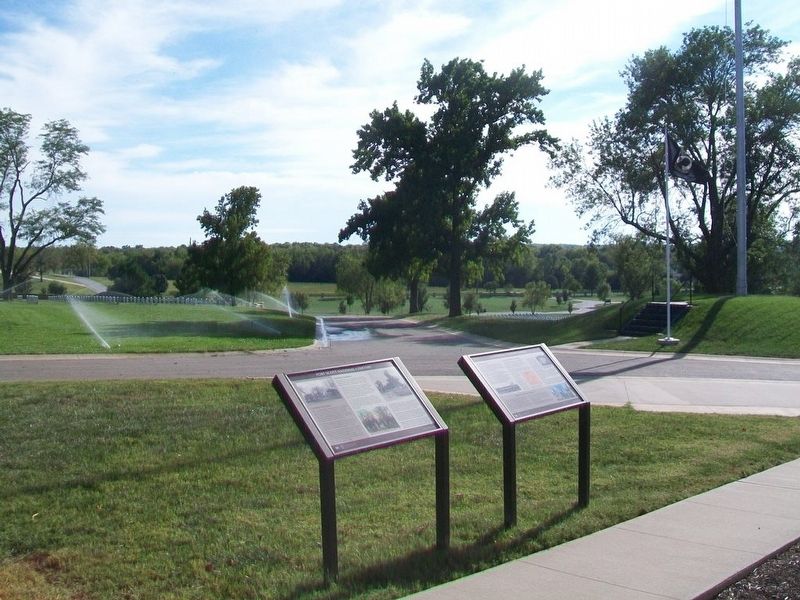Fort Scott National Cemetery
Civil War Fort Scott
Fort Scott, founded 1842, was named for former commander-in-chief of the U.S. Army, Gen. Winfield Scott. The army abandoned the fort in 1853, but the Civil War prompted federal troops to return in 1862. Fort Scott became the headquarters of the Department of Kansas and an important supply depot. Pro-Union supporters in Kansas—white, black, and American Indian—also found refuge here.
The first black regiment recruited in a Northern state, the 1st Kansas Colored Infantry, mustered into service at Fort Scott on January 13, 1863. The 2nd Kansas Colored Infantry was organized here in fall 1863 before departing for Arkansas.
Prior to this, in late October 1862, a group of 224 Union soldiers, seven officers, and several scouts—men who later served in the 1st Kansas Colored Infantry—left Fort Scott for Missouri in search of Confederates. They quickly found them. At Island Mound fighting lasted two days. The 1st Kansas "fought like tigers," reported a Union lieutenant. It was the first of many battles where the regiment excelled.
National Cemetery
From 1842 to 1853, seventeen individuals were buried in the Fort Scott post cemetery. When the fort was reoccupied in 1862, the U.S. Army established a new area as Fort Scott National Cemetery for the interment of
An 1867 law directed the secretary of war to appoint a "meritorious and trustworthy" superintendent to manage the national cemetery. To qualify for this position, the individual had to have been an enlisted man disabled in service. These restrictions were loosened over time. Absalom Hyde, formerly a captain in the 16th Kansas Cavalry, was named superintendent here in July 1868.
The U.S. Army improved the cemetery in the 1870s. A stone wall enclosed the 5-acre property, which contained 492 interments, including fourteen Confederate prisoners. A brick Second Empire-style lodge housed the superintendent and his family. Prior to its completion, the superintendent lived in town.
Several notable Civil War soldiers are buried or memorialized in the cemetery. A large sandstone boulder marks the grave of Capt. Eugene F. Ware, 7th Iowa Cavalry, who worked as a lawyer and author, known as "Ironquill," after the war. He died in 1911 (west end of Sections 10 and 13, Grave 1).
Also buried here are sixteen American Indian soldiers who enlisted in Union Indian Home Guard during the Civil War. These regiments were made up of loyal refugees who came to Kansas from Indian Territory (Oklahoma) in 1861 and 1862. The men served as scouts for other Union regiments.
A granite monument dedicated to soldiers of the 1st Kansas Colored Infantry and the 2nd Kansas Battery
To learn more about benefits and programs for Veterans and families, visit www.va.gov
Erected 2017 by U.S. Department of Veterans Affairs, National Cemetery Administration.
Topics and series. This historical marker is listed in these topic lists: Cemeteries & Burial Sites • War, US Civil. In addition, it is included in the Fort Scott, Kansas, and the National Cemeteries series lists. A significant historical date for this entry is January 13, 1863.
Location. 37° 49.309′ N, 94° 41.54′ W. Marker is in Fort Scott, Kansas, in Bourbon County. Marker is adjacent to the Fort Scott National Cemetery Administration Building. Touch for map. Marker is at or near this postal address: 900 East National Avenue, Fort Scott KS 66701, United States of America. Touch for directions.
Other nearby markers. At least 8 other markers are within 2 miles of this marker, measured as the crow flies. A National Cemetery System (here, next to this marker); In Memory of The Soldiers (within shouting distance of this marker); Jeannette Huntington Ware (about 400 feet away, measured in a direct line); a different marker also named Fort Scott National Cemetery (about 400 feet away); Combat Infantrymen (approx. 0.2 miles
Regarding Fort Scott National Cemetery.
The contributor served as the National Park Service historian at Fort Scott National Historic Site from 2010-2016 and is compelled to correct/clarify some points made on the marker:
1. Winfield Scott's proper title was "General-in-Chief."
2. The fort was not abandoned, but closed in 1853 (when Fort Riley was established), with an Army NCO and the post sutler and his family remaining at the fort. After the Kansas-Nebraska Act opened the territory to white settlement, the fort buildings were auctioned in 1855 and the civilian town of the same name was created. Hence, there was no "fort" to return to in 1862 but a town that had begun to be militarized by state troops in 1861.
3. The 1st Kansas Colored Infantry Regiment was organized as a state unit in the summer of 1862 and was called such from that point forward; it was "federalized" in January 1863 (after the Emancipation Proclamation authorized black recruitment) and was renamed the 79th US Colored Troops (New) in 1864.
4. Three Indian Home Guard regiments were organized in Kansas. While some American Indians individually served as scouts to federalized regiments, the Indian Home Guard regiments fought as units at engagements such as Prairie Grove and Honey Springs.
5. It was a Confederate guerrilla who stated that the men of the 1st Kansas Colored "fought like tigers," as recorded in the New York Times issue published on November 19, 1862.
6. What became the Fort Scott National Cemetery was earlier established as the Presbyterian Cemetery, and grew in acreage as military deaths increased following the war's 1861 commencement. Per the Fort Scott National Cemetery website,
"In 1861, town officers and citizens of Fort Scott purchased approximately four acres southeast of the old post for use as a community burying ground. Since the cemetery was controlled by the Presbyterian Church, it was known as the Presbyterian Graveyard. After the start of the Civil War, the new cemetery was used for the interment of soldiers stationed at Fort Scott. When Congress approved the creation of national cemeteries in 1862, the cemetery became one of 14 national cemeteries to be designated or established as such that year. On Nov. 15, 1862, the Presbyterian Graveyard and an adjoining tract owned by the Town Company were designated as Fort Scott National Cemetery."
Hence, it was not the U.S. Army that established the "new" cemetery.
Also see . . .
1. Fort Scott National Cemetery. (Submitted on October 1, 2017, by William Fischer, Jr. of Scranton, Pennsylvania.)
2. "Fort Scott, Kansas" in Civil War on the Western Border. Article written by the contributor to provide better context about Fort Scott the frontier US Army garrison and the civilian town. (Submitted on October 1, 2017, by William Fischer, Jr. of Scranton, Pennsylvania.)
Credits. This page was last revised on September 1, 2020. It was originally submitted on October 1, 2017, by William Fischer, Jr. of Scranton, Pennsylvania. This page has been viewed 313 times since then and 27 times this year. Photos: 1, 2. submitted on October 1, 2017, by William Fischer, Jr. of Scranton, Pennsylvania.

